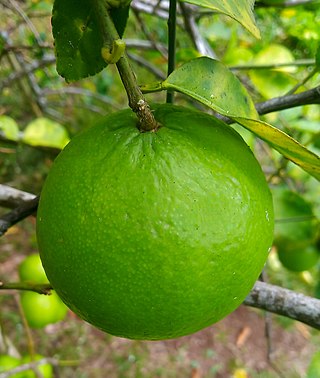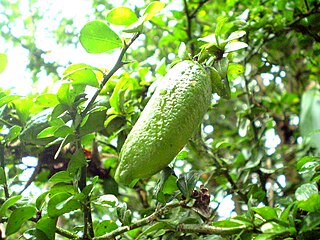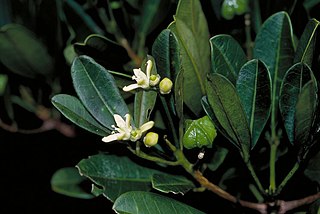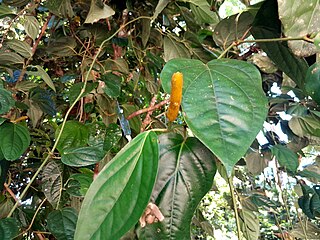
Citrus is a genus of flowering trees and shrubs in the rue family, Rutaceae. Plants in the genus produce citrus fruits, including crops such as oranges, mandarins, lemons, grapefruits, pomelos, and limes. The genus Citrus is native to South Asia, East Asia, Southeast Asia, Melanesia, and Australia. Various citrus species have been used and domesticated by indigenous cultures in these areas since ancient times. From there its cultivation spread into Micronesia and Polynesia by the Austronesian expansion ; and to the Middle East and the Mediterranean via the incense trade route, and onwards to Europe and the Americas.

A lime is a citrus fruit, which is typically round, green in color, 3–6 centimetres (1.2–2.4 in) in diameter, and contains acidic juice vesicles.

Australian limes are species of the plant genus Citrus that are native to Australia and Papua New Guinea.

The Key lime or acid lime is a citrus hybrid native to tropical Southeast Asia. It has a spherical fruit, 2.5–5 centimetres in diameter. The Key lime is usually picked while it is still green, but it becomes yellow when ripe.

Citrus australasica, the Australian finger lime or caviar lime, is a thorny understorey shrub or small tree of lowland subtropical rainforest and rainforest in the coastal border region of Queensland and New South Wales, Australia.

Citrus glauca, commonly known as the desert lime, is a thorny shrub or small tree native to Queensland, New South Wales, and South Australia. The 1889 book The Useful Native Plants of Australia records common names native kumquat and desert lemon.

Murraya paniculata, commonly known as orange jasmine, orange jessamine, china box or mock orange, is a species of shrub or small tree in the family Rutaceae and is native to South Asia, Southeast Asia and Australia. It has smooth bark, pinnate leaves with up to seven egg-shaped to elliptical leaflets, fragrant white or cream-coloured flowers and oval, orange-red berries containing hairy seeds.

Citrus australis, the Dooja, round lime, Australian lime or Australian round lime, is a large shrub or small tree producing an edible fruit. It grows in forest margins in the Beenleigh area and northwards, in Queensland, Australia.
Clymenia is a small genus of flowering plants in the family Rutaceae with two species. The genus is often included in Citrus.

Didymocheton pettigrewianus, commonly known as spur mahogany, spurwood, or Cairns satinwood, is a large tree in the family Meliaceae. It is native to the rainforests of Malesia, Papuasia and Queensland. In Queensland it occurs only in a small part of the northeast coast.
Hollandaea is a small genus of plants in the family Proteaceae containing four species of Australian rainforest trees. All four species are endemic to restricted areas of the Wet Tropics of northeast Queensland.

Catalepidia is a monotypic genus in the family Proteaceae which is endemic to Queensland, Australia. The sole described species is Catalepidia heyana, commonly known as Hey's nut oak. It is a medium sized tree growing up to about 18 m (59 ft) tall, and is found only in upland rainforest above 600 m (2,000 ft) on granite soils, ranging from the Windsor Tableland to the Atherton Tableland.

Lasjia is a genus of six species of trees of the family Proteaceae. Three species grow naturally in northeastern Queensland, Australia and two species in Sulawesi, Indonesia. Descriptively they are the tropical or northern macadamia trees group. Lasjia species characteristically branched compound inflorescences differentiate them from the Macadamia species, of Australia, which have characteristically unbranched compound inflorescences and only grow naturally about 1,000 km (620 mi) further to the south, in southern and central eastern Queensland and in northeastern New South Wales.

Citrus garrawayi, the Mount White lime, is a tree native to the Cape York region of northern Queensland in Australia. It is an understory tree in tropical rainforests.
Citrus wintersii, the Brown River finger lime, is a shrub native to the Brown River region in Papua-New Guinea. It was previously known as Microcitrus papuana. It has, as the "finger" name suggests, a small, thin fruit, pointed at both ends. It grows near Port Moresby.
Citrus warburgiana. the kakamadu or New Guinea wild lime, grows on the south coast of the Papuan Peninsula near Alotau in Papua-New Guinea.

Citrus taxonomy refers to the botanical classification of the species, varieties, cultivars, and graft hybrids within the genus Citrus and related genera, found in cultivation and in the wild.

Leptospermum wooroonooran, commonly known as wurunuru or mountain teatree, is a species of stunted tree that is endemic to Queensland where it grows on exposed mountain ridges. It has thin, fibrous or flaky bark, lance-shaped leaves with the narrower end towards the base, white flowers arranged singly on short side shoots and fruit remain on the plant at maturity.

Acronychia chooreechillum, commonly known as mountain aspen, is a species of shrub or small rainforest tree that is endemic to north-eastern Queensland. It has mostly trifoliate leaves with elliptic to egg-shaped leaflets on stems that are more or less cylindrical, flowers in small groups in leaf axils and fleshy, egg-shaped or elliptical fruit.

Piper mestonii, commonly known as Queensland long pepper or simply long pepper, is an evergreen vine in the pepper family Piperaceae native to rainforests of New Guinea and Queensland, Australia.
















